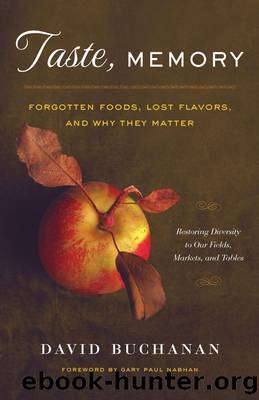Taste, Memory Forgotten Foods, Lost Flavors, and Why They Matter by David Buchanan

Author:David Buchanan
Language: eng
Format: epub
Published: 2012-11-08T16:00:00+00:00
To date Minnesota’s revenue has amounted to over $10 million, divided equally among the school, Honeycrisp’s breeders, and a fund for ongoing projects. This influx of cash has been critical for sustaining the Minnesota horticulture program, particularly since budget shortfalls forced state funding cuts several years ago.
The need to recoup costs also explains some of the hyped-up marketing behind this apple. Trade organizations, websites, and a dedicated Wikipedia page heap lavish praise on Honeycrisp, and a 2006 vote of the Minnesota state legislature designated it their official state fruit (take that, Keepsake and Haralson!). Honeycrisp was “the best, most exciting apple we’ve ever introduced,” according to Minnesota horticulture professor Jim Luby. “Explosively crisp!” writes their website. Even the name Honeycrisp has the ring of an advertising slogan to me, and it’s easy to feel nostalgic for others that hold something back, particularly if they hint at a rich history: Rhode Island Greening, Northern Spy, Roxbury Russet, or even the humble Baldwin. Honeycrisp sounds like something you might order at the Dunkin’ Donuts drive-thru, or the name of a breakfast cereal. Not quite worthy of a high-quality new fruit, but never mind …
Public-minded programs at Cornell and Minnesota need to find innovative ways to stay afloat in challenging financial times. As appealing as Cornell’s open-source sharing may be, there are advantages as well in Minnesota’s willingness to borrow strategies from the business world. And yet we need to guard against complacency. By creating commercial incentives to market new fruit aggressively, patenting can work against diversity and overshadow other deserving fruit. Is Honeycrisp really the perfect apple that can supplant all others? Older Minnesota releases like Sweet Sixteen are also outstanding, deserving a place at the table. Would Charles Boothby really trade every ancient Gravenstein and Ashmead’s Kernel for this relatively new release?
The Baldwin’s story should give us pause. Narrowing the range of fruits in the field has risks, today as much as in the past. According to an Integrated Pest Management bulletin sponsored by Cornell University, West Virginia University, the USDA, and the National Science Foundation, “Over the last decade, consumer and market demands have forced major changes in horticultural practices” for orchard fruits. When it comes to a highly contagious and damaging disease like fireblight, for example, these changes have “not only increased chances for infection but the level of damage/infection likely to occur.” What are the implications for Honeycrisp?
Fireblight is a particular concern here in the Northeast. This is a bacterial infection that infects numerous plants, and it shares hosts ranging from raspberries to hawthorns to roses. Epidemics are hard to predict. When temperature and humidity conditions are right the disease can erupt with great speed, destroying blossoms, leaves, and branches. Although frequent antibiotic spraying offers preventive control for conventional growers, applications are expensive, and bacteria can evolve in turn. Planting resistant varieties and following good horticultural practices, like burning infected vegetation and diversifying plantings, is the best line of defense. High-density orchards planted on dwarf rootstocks, which are
Download
This site does not store any files on its server. We only index and link to content provided by other sites. Please contact the content providers to delete copyright contents if any and email us, we'll remove relevant links or contents immediately.
| Culinary Biographies | Essays |
| Food Industry | History |
| Reference |
For the Love of Europe by Rick Steves(3418)
The Sprouting Book by Ann Wigmore(3058)
BraveTart by Stella Parks(2977)
Better Homes and Gardens New Cookbook by Better Homes & Gardens(2963)
The Death of the Heart by Elizabeth Bowen(2910)
Salt, Fat, Acid, Heat: Mastering the Elements of Good Cooking by Nosrat Samin(2665)
Sauces by James Peterson(2597)
Classic by Mary Berry(2506)
Solo Food by Janneke Vreugdenhil(2497)
The Bread Bible by Rose Levy Beranbaum(2479)
Ottolenghi - The Cookbook by Yotam Ottolenghi(2366)
Martha Stewart's Baking Handbook by Martha Stewart(2336)
Kitchen confidential by Anthony Bourdain(2321)
Betty Crocker's Good and Easy Cook Book by Betty Crocker(2286)
Day by Elie Wiesel(2250)
Hot Sauce Nation by Denver Nicks(2110)
The Plant Paradox by Dr. Steven R. Gundry M.D(2052)
My Pantry by Alice Waters(2048)
The Kitchen Counter Cooking School by Kathleen Flinn(2017)
